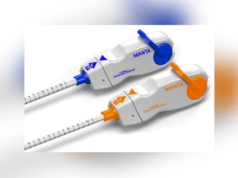
Teleflex has announced the first patient enrolment in a clinical study that is intended to demonstrate the safety of the Manta vascular closure device using ultrasound guidance, without dependence on preprocedural depth locator measurements. The study will enroll patients undergoing elective transcatheter aortic valve implantation (TAVI) procedures with planned percutaneous femoral arterial access.
Enrolling up to 150 patients in up to 15 investigational sites across the USA and Canada, the MANTA Ultra study is a prospective, multicentre, single-arm trial employing the primary safety endpoint of any large bore access-site related Valve Academic Research Consortium-2 (VARC-2) major vascular complication within 30 days (adapted from VARC-2 Criteria). The occurrence of access site complications is known to be associated with higher rates of morbidity and mortality and increased costs associated with prolonged length of stay.
The practice of ultrasound-guided access has been associated with a reduced risk of major and minor access site vascular complications, as well as reduced risk of life threatening, major, and minor access site bleed complications. Teleflex is committed to exploring whether the known benefits of ultrasound-guided access will translate to ultrasound-guided closure, resulting in safe Manta device deployment, the company said in a press release.
The principal investigators of the study include David A Wood (University of British Columbia Centre for Cardiovascular Innovation, Vancouver, Canada) and Vijay S Iyer (University of Buffalo, Buffalo, USA).
“We are excited to embark on the Teleflex MANTA Ultra study,” said Wood. “We expect the study results to show that the use of ultrasound further aids in avoiding Manta device deployment complications attributed to anchor malpositioning by providing direct visualisation of the closure process.”
With visualisation of the access site during Manta device deployment, the study intends to demonstrate that ultrasound allows for precise deployment and positive positioning of the Manta device anchor within the vessel. This approach, if proven effective, will allow the Manta device to be used in clinical scenarios where the baseline arterial depth is not measured, or may have changed intraoperatively or postoperatively. Manta device ultrasound-guided closure is intended to be an alternative method to the conventional pre-procedural depth locator measurement technique that can provide additional procedural flexibility to operators.
In addition to the primary safety endpoint, the study will employ a secondary endpoint of any large bore access-site related VARC-2 minor vascular complication within 30 days (adapted from VARC-2 criteria) and secondary effectiveness endpoints that include time to haemostasis, technical success, ambulation success, time to ambulation, treatment success and procedure time—all with 30-day and 12-month follow-up timepoints.











